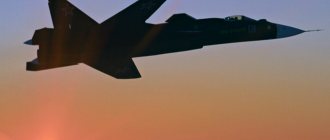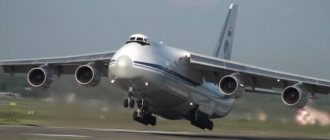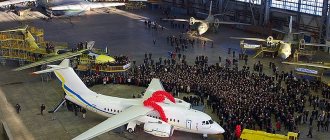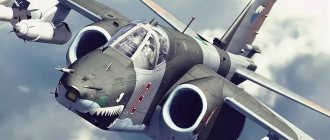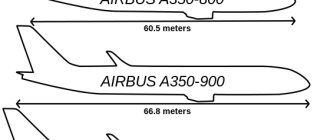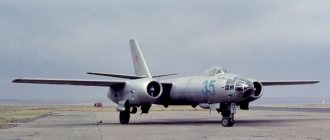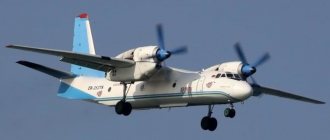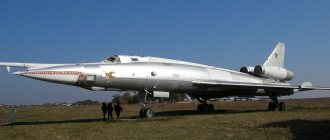Flight performance
| IL-62 | Il-62M | |
| Engines | NK-8-4 | D-30KU |
| Take-off thrust, kgf | 4x10500 | 4x11000 |
| Dimensions, m: wingspan length height | 43,2 53,12 12,35 | 43,2 53,12 12,35 |
| Wing area, m2 | 279,55 | 279,55 |
| Weight, kg: empty take-off normal | 72 161,6 | 72 165 |
| Commercial load weight, t | 23 | 23 |
| Fuel capacity, l. | 100000 | 105000 |
| Number of passengers, people | 168-186 | 168-186 |
| Speed, km/h: cruising landing | 850 265 | 870 265 |
| Flight range, km: with maximum refueling and load 10 tons with maximum payload | 10000 7550 | 11050 8300 |
| Cruising altitude, km | 9,5-12 | 9,5-12 |
| Run length, m run, m | 2930 1000 | 2250 1000 |
| Crew (flight), persons. | 5 | 5 |
Il-62: the last plane of the great Ilyushin
Published: 04/14/2020 19:26
A new era of civil aviation was opened in Kazan
When talking about aircraft manufacturing in Tatarstan, we traditionally think about the production of military equipment. However, one cannot fail to note the republic’s enormous contribution to the development of the civil air fleet. One of the brightest pages in the history of the Kazan Aviation Plant was the production of the Il-62 and subsequent modifications of one of the best Soviet airliners.
BY SCREWS!
Today, Airbuses and Boeings reign almost unchallenged in the Russian skies, whose pilots conduct official negotiations in English and measure space in feet and miles. And less than thirty years ago, the calling card of the country was the passenger aircraft of Ilyushin and Tupolev, which annually transported tens of millions of passengers.
The iconic Soviet car was the Il-62. Advanced design solutions made it comfortable, easy to operate and maintain, and, most importantly, reliable and safe. In the early sixties, it became the first Soviet intercontinental turbojet airliner. Its creation was determined by global trends and the country’s internal need for a car capable of flying non-stop from Moscow to Khabarovsk and Havana.
The continued use of the Tu-114 turboprop, which solved this problem, was abandoned partly for political reasons. Firstly, the country's prestige required the development of jet aviation. Secondly, the Americans reacted very nervously to the close relationship of the machine with the Tu-95 strategic bomber. Well, how does a passenger plane pave the way for a nuclear missile carrier, or will it itself turn out to be a wolf in sheep's clothing? And objectively: the four giant “double” propellers of the machine are the source of powerful low-frequency noise that makes your insides vibrate. Or maybe it’s an airplane with jet engines mounted on a special pylon in the tail section. The difference in acoustic comfort is the same as between the cabin of a tractor and the interior of a car.
ABOUT COLLEAGUES AND COMPETITORS
The creation of the aircraft was entrusted to the Sergei Ilyushin Design Bureau. The Tupolev team, the trendsetters in long-range aviation, were busy with other projects, which allowed their colleagues to reveal their potential. Il-62 became the first long-range airliner of the second generation in the USSR and the last aircraft in the creation of which the great Ilyushin personally took part. The car became the finest hour of his student and successor Genrikh Novozhilov.
A surprisingly democratic atmosphere reigned in the Ilyushin company, with which the Kazan Aviation Plant began to closely cooperate. According to the recollections of veterans, there were a lot of young people and any novice design engineer could convey some of his ideas to the level of the general designer, be heard and understood. Fresh solutions coupled with previous developments made it possible to make the IL-62 breakthrough and meeting all international requirements. And beautiful in every sense. The perfection of the aerodynamic shape of this “bird” made us forget about its take-off weight of 160 tons.
A huge contribution to the creation and fine-tuning of this machine, of course, was made by KAPO (now KAZ) named after Gorbunov: designers, engineers and production organizers became state prize laureates. The first-born in the series was transferred to the plant's flight test station in January 1966 and made its first flight in mid-February. And on September 15 of the same year, the Il-62 officially entered service with Aeroflot.
In the mid-sixties, the Il-62 became the first Soviet turbojet aircraft capable of covering intercontinental distances
The appearance of a new aircraft in the USSR aroused the jealousy of Western competitors. And its echoes, surprisingly, are still heard today. Not long ago, a website was discovered where the IL-62 was called “an unsuccessful pirated copy of a Western design in the poorest quality.” The reason for this harsh assessment is that “it is very similar to the British Vickers VC-10 aircraft.” And, of course, the Soviet aircraft a priori had safety problems. True, he “could continue the flight on two engines and even make a repeat approach with two engines inoperative,” but only on the condition “that other systems, and especially the control system, were in working order.” Apparently, aircraft abroad were controlled by the power of thought.
Meanwhile, external similarities are present in a number of classmate airliners, as dictated by aerodynamics. When it comes to safety, there is no perfect technology. Over more than half a century of operation of the Il-62 family, out of 289 vehicles produced, there were sixteen accidents in which people were injured (including test flights). Design flaws were the cause of four such cases. According to open sources, Vickers lost seven of its 54 vehicles in accidents. That is, “ours” are five and a half percent of accidents against at least thirteen “theirs.” At the same time, the British aircraft was in commercial operation only until 1981, and ours until the beginning of the third millennium.
FACTS FOR COUNTERPROPAGANDA
...The final “depth” of the analysis of the authors of the ill-fated site became clear from the information about the tests of the aircraft, which were carried out by “I. Virinkov”, “E. Kuznetsov” and “B. Mazkavtsev”. The said “pilots” were born, apparently, as a result of a careless translation of a foreign article. This disgrace would probably not be worth talking about if it were not a clear example of a modern order for low-grade propaganda. It can and should be resisted with objective facts, which often lie on the surface. It is enough to look, for example, at the corresponding Wikipedia article to find out: at the helm of the Il-62 sat honored test pilots - Heroes of the Soviet Union Yakov Vernikov, Eduard Kuznetsov and Boris Mashkovtsev. Boris Vyacheslavovich, by the way, raised in Kazan not only the first production Il-62, but also the Il-62M. And in both cases, what was installed on the wing was not some kind of “pirate copy,” but a unique machine.
A veteran at the Il-62M monument in Sheremetyevo.
Four three-ton engines located in the tail shifted the center of gravity “from its usual place”, which ended up behind the main landing gear. On other liners with a similar layout, the issue of stability was solved by moving the landing gear along with the wings back. As a result, the load on the rudders increased significantly and required the use of boosters (hydraulic boosters) - “intermediaries” between the pilot and the aircraft. The IL-62 was created using a boosterless design, unprecedented for such a vehicle, in which there was almost nothing to break. Thanks to the perfection of engineering and aerodynamic solutions, control of the huge airliner was easily carried out mainly by the muscular power of the pilot (or the operation of the autopilot) through mechanical rods. And to prevent the empty plane from tipping over, a special support was installed in the tail of the plane.
On the first flight, which was performed by the famous Vladimir Kokkinaki in January 1963, a funny thing happened with the tail support. The flight engineer, influenced by previous experience, did not realize that it needed to be removed before takeoff. And it broke, damaging the fuselage when the plane began to lift its nose. Nevertheless, the test program was completed and the car was repaired. It was distinguished by good maintainability.
Another feature of the huge airliner was the unique engine reverse. “Reverse thrust” made it possible to significantly reduce the length of the run, land in conditions of an icy runway, for example, and, to the delight of the public, move along the airfield... in reverse!
FROM BREZHNEV TO YELTSIN
The plane pleased passengers with silence in the cabins, a unique air conditioning system and maintaining air pressure comfortable for humans.
The vehicle was gradually modernized: the design of the wings was strengthened, their mechanization was improved, and instrumentation, navigation and cabin equipment were improved. Production Il-62s were equipped with modifications of the NK-8 dual-circuit engines. The Il-62M received more powerful (with a thrust of up to 10.7 tons) and at the same time economical D-30KU engines. Together with an additional fuel tank in the vertical part of the keel, this made it possible to confidently make direct flights from Moscow to New York.
The appearance of a new aircraft in the USSR aroused the jealousy of Western competitors. And its echoes, surprisingly, can still be heard
Modern characteristics, combined with an acceptable price and political situation, made the aircraft attractive to states friendly to the USSR, including, of course, countries of the socialist camp. However, in Czechoslovakia, after the events of the Prague Spring of 1968, cooperation did not improve immediately. And if Czechoslovak Airlines accepted and loved the airliner as such, they did not agree with the service scheme, nodding to the “capitalist” experience.
The former Soviet air service center placed the priority on maintaining the time between repairs, and then took the ship out of service for a long time. It was Czechoslovakia that forced us to switch to a scheme with phased repairs as specific parts wear out. Its terms no longer drove the owners into losses and depression. Genrikh Vasilievich Novozhilov, who accompanied his machines at all stages of production and operation, provided enormous assistance in solving the problem.
By the way, their flight biography continues to this day. Veterans serve conscientiously in law enforcement agencies and in the presidential air squad. Until 1995, the Il-62M “Salon” modification was in our country (as well as in a number of countries) “Air Force No. 1,” transporting both Brezhnev and Yeltsin. This clearly indicates the highest level of quality and reliability of the Kazan aircraft.
Photo: photosight.ru; aviator.guru
Author of the article: SHABARDIN Anton Issue: No. 55 (28824)
Add “Republic of Tatarstan” to your favorite sources on Yandex.News Subscribe to the “Republic of Tatarstan” channel in Yandex.Zen
- Farit:
05/03/2020 at 08:14
Thank you very much for the interesting publication about the unique achievement of the Soviet aviation industry. For 50 years of operation of the IL-62, there has not been a single major disaster! Our youth, who are already accustomed to the fact that all scientific and technical achievements come from the West, should know about this. I am an aviation engineer, from 1978 to 2000 I worked at KAPO named after. Gorbunova. I propose to dear Shabardin A. an interesting topic. In 1996, the heroic team of KAPO named after. Gorbunov was lifted onto the wing of the TU-214 airliner. It was a unique, completely Russian aircraft. Even the avionics were Russian. A wonderful aircraft, quite competitive with its Boeing 757 counterpart. But the Boeing lobby in Russia won, and the TU-214 never entered mass production. The main customer of the aircraft is the Presidential Air Squadron (more than 10 aircraft).
Answer
Add a comment
Click to cancel reply.
You may also be interested in
09.07.2020There is a new leader in the executive committeeKonstantin Yakovlev was elected Chairman of the Executive Committee of the Council of the Assembly of Peoples of Tatarstan... 1560 |
09.07.2020Socially vulnerable – food packagesThe fourth stage of the campaign “Yardem Yaneshe! Help is at hand! takes place in Nizhnekamsk... 1900 |
09.07.2020“Soviet Tataria” – as a gift to the Cheremsha MuseumThe funds of the Cheremshan Memorial Center were replenished with artifacts - newspapers “Soviet Tataria” for 1960... 1740 |
09.07.2020Hot days for Tatarstan firefightersTwo serious fires occurred in the republic on Wednesday. In Almetyevsk, a large shopping center was on fire, and in Kazan, a warehouse near an oil depot... 1840 |
09.07.2020Chistopol curiositiesWe continue to discover Tatarstan in a series of virtual excursions, fortunately you can go on them without a mask and gloves. This time we will stop by the district town of Chistopol…. 1970 |
IL 62
Soviet passenger aircraft Il 62 made its first flight on January 3, 1963
Il 62 is the first Soviet turbojet long-haul intercontinental passenger aircraft. The Soviet passenger aircraft Il 62 was developed at the Ilyushin Design Bureau in 1960, taking into account world requirements for aircraft of this class to replace Tu 114 aircraft. In terms of technical excellence, it corresponds to “second generation” turbojet passenger aircraft.
The first intercontinental passenger aircraft in the USSR was the turboprop Tu 114. However, at the turn of the late 1950s and early 1960s, jet passenger aviation began to rapidly develop in the world. In an effort to follow the latest technical achievements, the USSR began to study the issue of creating an intercontinental passenger airliner with turbojet engines. Tupolev, loaded with several passenger aircraft projects at once, completely abandoned such a project, and then another famous Soviet passenger aircraft designer, Sergei Vladimirovich Ilyushin, took up the implementation.
Il 62 was the last aircraft built under the leadership of Sergei Ilyushin. At the end of the 60s, Sergei Ilyushin retired for health reasons and the Ilyushin Design Bureau was headed by Novozhilov, who completed the design work and testing of the Il 62 aircraft.
Development of the Il 62 began in the early 1960s, when Aeroflot developed requirements for a long-range aircraft capable of making non-stop flights from Moscow to Khabarovsk and Havana. These requirements set the task of ensuring the greatest flight safety, maximum comfort for passengers and high economic efficiency. The aircraft had to have special equipment that would provide a safe solution in case of engine failure, as well as in areas of increased turbulence. In terms of safety, reliability, efficiency and flight range, it was supposed to be on par with the Boeing 707 and DC-8 aircraft.
When the aircraft was created, the USSR was not yet a member of the International Civil Aviation Organization (ICAO). However, it was decided to comply with the basic ICAO flight safety requirements on the aircraft.
The first prototype Il 62 USSR-06156 with AL-7 engines with a thrust of 7500 kgf first took to the skies on January 3, 1963. On the second prototype USSR-06153 in 1964, new NK-8 engines (9500 kgf) were installed, and later - modified NK-8-4. The tests continued for 4 years and in mid-1967 the aircraft entered service.
Since 1969, the Ilyushin Design Bureau began developing a modified version of the Il 62M. The new version, designated Il 62 M-200, differs (from the original Il 62) in a reinforced airframe design, double-slot flaps (instead of single-slot ones), an increased range of stabilizer adjustment angles and automation of its control, an improved configuration of the elevator nose, the inclusion of spoilers in the roll control wiring , new central control units, an improved control system, more powerful and economical D-30KU turbofan engines, improved aerodynamics of engine nacelles, placement of an additional fuel tank with a capacity of 5000 liters in the keel, a new TA-6A turbo unit, and significantly improved navigation equipment. As a result, the take-off weight of the Il 62M-200 aircraft increased from 160.5 tons for the Il-62 to 164.7 tons, by 4200 kg.
Flight tests of the Il 62 M aircraft were carried out in 1970-1972. It entered service in January 1973. From June 1974 to August 1978, the Ilyushin Design Bureau developed the Il 62 MK project, which featured increased capacity to 196 passengers and was designed for takeoff from a runway 2300-2600 m long. For this purpose, the chassis design was changed: the track was increased, the tire pressure was reduced, and the brakes, an air brake is provided on the wing. Since the aircraft was intended to be operated on medium-haul routes, the fuselage was strengthened to withstand a greater number of takeoffs and landings. However, this project was never realized. In July 1978, the first Il-62M (w/n SSSR-86484) with a reinforced wing and a take-off weight increased to 167 tons was put into operation. Strengthening the wing also increased the aircraft's lifespan.
Aircraft of the Il 62 family were mass-produced in 1966-1995 at the aircraft plant in Kazan. A total of 289 aircraft were built: 5 prototypes (built in Moscow), 94 Il 62 and 190 Il 62 M and Il 62 MK. 5 Il 62 M was laid down, but not completed. Of this number, 81 aircraft were manufactured for export to socialist countries: Angola, Hungary, East Germany, North Korea, China, Cuba, Mozambique, Poland, Czechoslovakia.
The Il 62 aircraft set several world speed and range records. For several decades, the Il 62 served and is serving as a government aircraft (“Air Force No. 1”) - in the USSR and North Korea.
Literature
- Andreev I. Fight for weight. // Technology for youth. - 1977. - No. 11. — P. 46-47.
- Belyaev V.V., Ilyin V.E. Russian modern aviation. - M.: AST, "Astrel", 2001. - P. 244-250.
- Vasiliev N. Aeroflot’s aging flagship: Airliner Il-62. // Wings of the Motherland. - 1997. - No. 7. — P. 1-4.
- Vulfov A. Flagman (IL-62: history of operation). // Aviation and astronautics. - 2001. - No. 3, 4.
- From the history of Soviet aviation: Aircraft of the S.V. Ilyushin Design Bureau / G.V. Novozhilov, D.V. Leshchiner, V.M. Sheinin, etc. - M.: Mashinostroenie, 1990. - P. 15-17, 233 -249.
- Chuev F.I. Ilyushin. - M.: “Young Guard”, 1998. - P. 217-223.
Fighters | Bombers | Stormtroopers | Scouts | Transport aviation | Helicopters | Naval aviation | Passenger aviation | Sports aviation | Special aviation | Aircraft | OKB | Aircraft factories | Aircraft carriers | Aerodrome equipment
